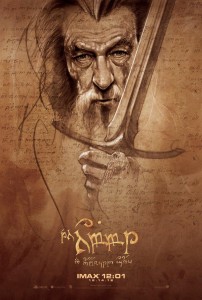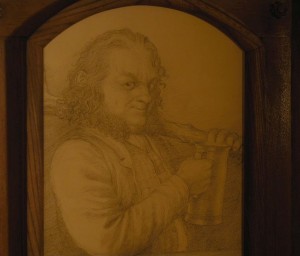 It is widely known that the novel called The Hobbit is supposed to be the journal, or autobiography of Bilbo Baggins, and his recollections of his adventures with Gandalf and the Company of Dwarves. In the beginning of both The Hobbit: An Unexpected Journey and The Lord of the Rings: Fellowship of the Ring, Bilbo is seen writing his story. That book is then passed along to Frodo to include his grand adventure, The Lord of the Rings, and then finally given to Sam to finish. But where does this love of storytelling come from?
It is widely known that the novel called The Hobbit is supposed to be the journal, or autobiography of Bilbo Baggins, and his recollections of his adventures with Gandalf and the Company of Dwarves. In the beginning of both The Hobbit: An Unexpected Journey and The Lord of the Rings: Fellowship of the Ring, Bilbo is seen writing his story. That book is then passed along to Frodo to include his grand adventure, The Lord of the Rings, and then finally given to Sam to finish. But where does this love of storytelling come from?
Again, in the FOTR in the chapter called “Concerning Hobbits” not only does Bilbo describe every little detail of just what is a Hobbit, but he mentions their love of genealogy, biographies, nature studies and maps. And while it is made clear Hobbits do not like going on Adventures, they are not opposed to listening to stories of adventure. Later on in FOTR, in Rivendell, there is a Hall of Fire, where songs are sung and stories told and thus, it becomes clear that Elves love storytelling as well. And finally, in The Hobbit during the Unexpected Party, the Dwarves sing their own songs tell some tales of their own history. It is clear that while Professor Tolkien is telling us a tale, to make each culture richer and seem more real, he is giving them individualized stories of their own within his greater story.
 And now, with The Hobbit: An Unexpected Journey, there is more singing, and many stories, and all of them are directly from Tolkien himself. Maybe the most unusual story is that of Bandobras Took, also known as Bullroarer Took. In the film, as in the book, it is Gandalf who tells the tale shortly after Bilbo has collapsed from fright at the prospect of meeting Smaug the Terrible. The only difference being that in the film, Gandalf is telling the story to Bilbo to bolster his courage by reminding him of his brave ancestry, and in the book, Gandalf is using that story to tell the Dwarves why he has chosen Bilbo in the first place. Either way, the story has Bullroarer Took riding into battle on an actual horse, since he was 4 foot 5 inches tall, and taking out the goblin’s leader, by the name of Golfimbul with one blow of his club. Golfimbul’s head does fly 100 feet into the air and does land in a rabbit hole, and the story always ends with same duel results, the battle was ended with the death of Golfimbul, and the game of Golf was invented. While this story is less epic than the attack of Smaug, or the history of the Ring and how Sauron lost it, it does illustrate Tolkien’s great love of storytelling and how stories help illuminate life.
And now, with The Hobbit: An Unexpected Journey, there is more singing, and many stories, and all of them are directly from Tolkien himself. Maybe the most unusual story is that of Bandobras Took, also known as Bullroarer Took. In the film, as in the book, it is Gandalf who tells the tale shortly after Bilbo has collapsed from fright at the prospect of meeting Smaug the Terrible. The only difference being that in the film, Gandalf is telling the story to Bilbo to bolster his courage by reminding him of his brave ancestry, and in the book, Gandalf is using that story to tell the Dwarves why he has chosen Bilbo in the first place. Either way, the story has Bullroarer Took riding into battle on an actual horse, since he was 4 foot 5 inches tall, and taking out the goblin’s leader, by the name of Golfimbul with one blow of his club. Golfimbul’s head does fly 100 feet into the air and does land in a rabbit hole, and the story always ends with same duel results, the battle was ended with the death of Golfimbul, and the game of Golf was invented. While this story is less epic than the attack of Smaug, or the history of the Ring and how Sauron lost it, it does illustrate Tolkien’s great love of storytelling and how stories help illuminate life.
On a side note, in Los Angeles every year in September, during the Baggins’ Birthday Bash at Griffith Park, a rousing match of Golfimbul is played, recreating the fateful act of Bullroarer Took defeating the Goblin leader Golfimbul


